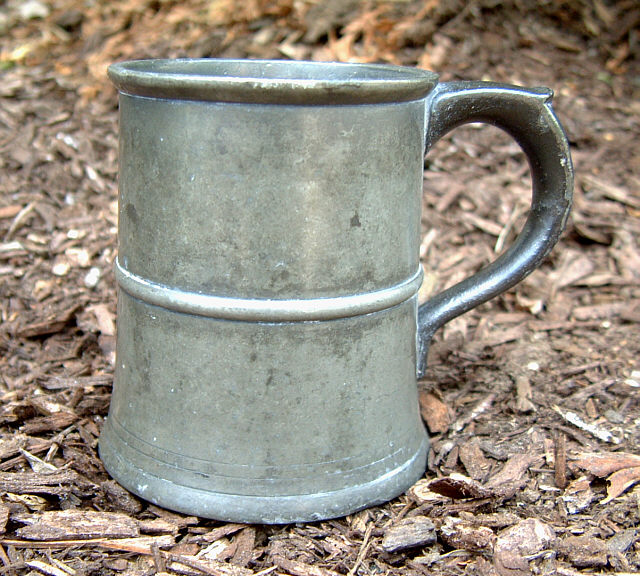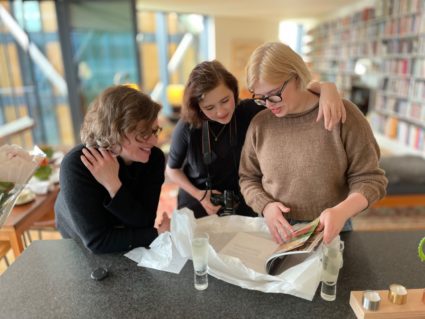of pints and other Britishisms

I can’t really blame the British. The entirety of measuring systems around the world are consistent only in their inconsistencies. I grew up (why, I can’t imagine: how many times can the adage have come in handy?) chanting, “A pint’s a pound the world around.” But it isn’t. The British can use, legally, the word pint to refer in fact to 20 fluid ounces, but ONLY of lager. Other references to pints have to conform to the 16-ounce variety. And as you know, I frequently find the European obsession with weighing ingredients to be annoying, but I can see that’s only a matter of familiarity. I’m sure it is more exact to weigh butter than to squint at the little “tbsp” measuring lines on the tinny paper used to wrap sticks of butter in America. I think I prefer the measurement “knob” of butter to all others.
But today I am really flummoxed. I have in my hot little hands the treasured recipe for Islesford Dock Chowder, quite simply the best incarnation of clam chowder on this earth. However. Who on EARTH measures bacon in QUARTS? I understand that I’ve been given the restaurant-size recipe, which is actually amusing and brings back happy memories of making vast quantities of soup for a homeless men’s shelter when we lived here in the 1990s. How much fun I had producing gallons of tomato-fennel soup with cheese croutons, vichyssoise for 50, creamy carrot and lentil soup to feed the masses. So it’s not the NOTION of the quantity that’s bothering me, it’s how on earth you measure a quart of bacon. If a pint’s a pound the world around and there are two pints to the quart, and you need two quarts of bacon, then how many Iowa schoolchildren does it take to detassel a field of corn? Sorry, that’s actually a question on the Graduate Record Examination.
And another thing: can anyone tell me why the word “lieutenant” is pronounced here with a mysterious phantom “f” in the middle? “Leftenant?” John reports listening to an interview on BBC Radio 4 with an American soldier who, halfway through the discussion exploded: “Stop calling me ‘Leftenant,’ it’s LOOTENANT!” I really don’t understand.
Today will see us reluctantly visiting the new Westfield Shopping Centre at the dreaded Shepherd’s Bush roundabout, reputedly the largest shopping centre in all of Great Britain, the construction site of which was the scene of so many anxiety-making traffic-clogged school runs last summer. My feeling is that if we neighborhood residents are to be tormented with the crowds of people and cars caused by this monstrosity of capitalism, I should at least see what the new Waitrose cheese room is like. And I’ve heard great things about the fish counter, so tonight could well be my friend Vincent’s creamy salmon piled with julienned vegetables. It’s a fiddly, time-consuming, obsessive-compulsive dish and therefore ideal for a rather grey, frustratingly dull day. I’m giving you Vincent’s exact phrasing because I can hear his voice, and it brings him comfortingly a little closer to me as I cook.
Vincent’s Salmon with Cream & Vegetables
Preparation time: 10–15 minutes
Cooking Time: 25–30 minutes
Level of Difficulty: Very Easy
Occasion: Dinner Party or Sunday Lunch
Approx 1 Kilo of Salmon Fillet in one piece if possible — (Enough to
feed 4 generously or 6 if you’re having a starter)
3 Medium to large carrots
1 Large fennel bulb
1 Medium Onion
1 Large Red Pepper
2 Large Celery Stalks
200g Green Vegetables (Green Beans, Asparagus etc.)
3 Tbsp Chopped Flat Leaf Parsley
1 1/2 Tbsp Chopped Dill
1 1/2 Tbsp Chopped Chervil (Not absolutely necessary)
Grated Rind of 1 Lemon
Juice of 1 Lemon
400 ml Creme Fraiche
150 ml White Wine (Chardonnay, Viognier, Sauvignion Blanc)
Preheat your oven to 200C (Medium hot oven). Put the vegetables through a food processor with a shredding/julienne blade. Transfer the grated vegetables to a mixing bowl. Add the grated lemon rind. In a separate mixing bowl, add the Creme Fraiche, lemon juice, white wine, chopped herbs and mix well. Season this with generous amounts of pepper and some salt. Pour the liquid mixture over the vegetables and mix thoroughly. When you’re done, you should have a very wet mix of vegetables sitting in but not covered by liquid.
Partially strain and arrange 3/4 of the vegetable mixture evenly on the bottom of a large and flat backing pan/tray. Place the salmon fillet skin-side down on the vegetables. Season the salmon. Strain and place the remainder of the vegetables on the fish. You should have about 1 1/2 cups of liquid left in the bottom of your mixing bowl. Pour that over the salmon.
Bake the salmon for 25–30 minutes, checking half-way and basting the fish with some of the cooking liquid. When the time is up, check that the fish is cooked. It should be a bit “pink” in the middle.
***************


Hi, Kristen. We love that clam chowder, and aree only occasionally able to get to Maine (once very two- four years.). Would you be willing to share the recipe? W would really appreciate it.…
Thanks, Debby Rickards
I came across your website in my desperate search to understand how the Ilseford Dock on Little Cranberry Island created what I think is the most incredible clam chowder. I have had lots of good ones but never like their dock recipe. In one of your posts you mentioned that you had the recipe. Can you offer any direction on how to come close to duplicating this wonderful chowder?
I really appreciate any assistance and am intrigued by your site and other recipes. I’m very happy my search lead me to you!
Thanks again,
Andrew